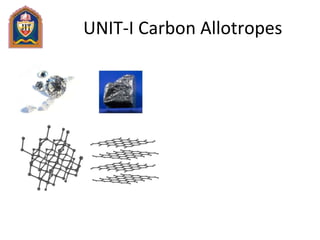
Unit 1.3 Carbon allotrops(graphite &; fullerene)
- 1. ENGINEERING CHEMISTRY DR FARHAT A ANSARI ASSISTANT PROFESSOR (AS) JETGI
- 3. Allotropes • Carbon can bond with itself in at least three different ways giving us 3 different materials – Diamond – Graphite – Buckyballs and nanotubes
- 4. Diamond • Carbons are bonded via sp3 hybridization to 4 other carbon atoms forming a giant network covalent compound.
- 5. Properties of Diamond • High melting point due to strong directional covalent bonds (3550 C) • Extremely hard because it is difficult to break atoms apart or move them in relation to one another • No electrical conductivity because electrons are localized in specific bonds • Insoluble in polar and non-polar solvents because molecular bonds are stronger than any intermolecular forces
- 6. Graphite • Carbon atoms are bonded via sp2 hybridization. • Carbon atoms form sheets of six sided rings with p-orbitals perpendicular from plane of ring.
- 7. Graphite Structure • Carbon has 4 valence e- to bond with. 3 are used for closest atoms in rings. 1 is delocalized in p-orbitals • The presence of p- orbitals allows for strong van der waals forces that hold the sheets together
- 8. Properties of Graphite • Different from Diamond – Conducts electricity because of delocalized electrons – Slippery can be used as lubricant, sheets can easily slip past each other (think of a deck of cards) • Same as Diamond – High melting point (higher actually because of delocalized e-, 3653C) – Insoluble (same reason)
- 9. Fullerenes • Buckyballs: spherical • Nanotubes: tube shaped • Both have very interesting properties – Super strong – Conduct electricity and heat with low resistance – Free radical scavenger
- 10. Buckyballs • Carbon atoms bond in units of 60 atoms (C-60) forming a structure similar to a soccerball with interlocking six sided and five sided rings. • sp2 hybridization • Extra p-orbitals form pi bonds resulting in – Electrical conductivity – Stronger covalent bonds, therefore stronger materials
- 11. Band Theory of Solids In isolated atoms the electrons are arranged in energy levels UNIT-I BAND THEORY OF SOLIDS
- 12. In solids the outer electron energy levels become smeared out to form bands The highest occupied band is called the VALENCE band. This is full. For conduction of electrical energy there must be electrons in the CONDUCTION band. Electrons are free to move in this band.
- 13. Insulators : There is a big energy gap between the valence and conduction band. Examples are plastics, paper ….. Conductors : There is an overlap between the valence and conduction band hence electrons are free to move about. Examples are copper, lead …. Semiconductors : There is a small energy gap between the two bands. Thermal excitation is sufficient to move electrons from the valence to conduction band. Examples are silicon ,germanium….
- 14. When a conductor is heated its resistance increases ; The atoms vibrate more and the electrons find it more difficult to move through the conductor. R T R But in a semiconductor the resistance decreases with an increase in temperature. Electrons can be excited up to the conduction band. Conductivity increases
- 15. Valence band: Band occupied by the outermost electrons Conduction: Lowest band with unoccupied states Conductor: Valence band partially filled (half full) Cu. or Conduction band overlaps the valence band